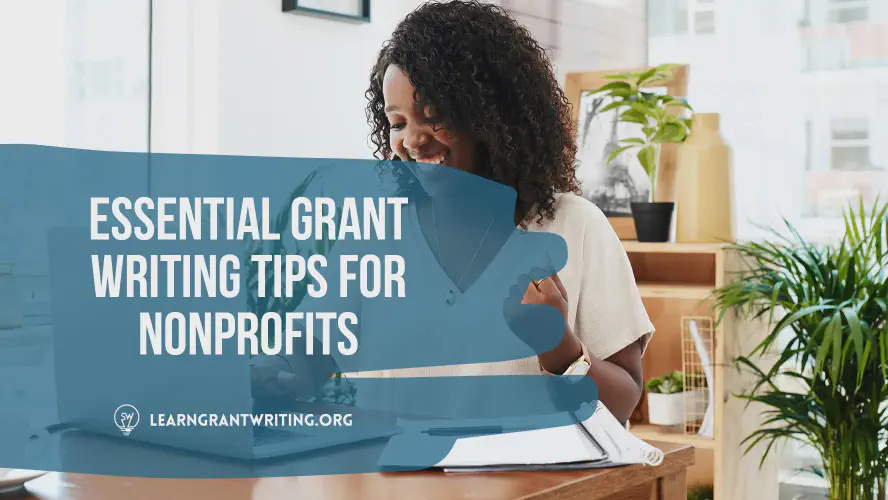Let's say a new task just landed on your plate: Securing more funding for your nonprofit.
But you're stretched for time. Grant opportunities are pouring in through your inbox from the board. They're all due in two weeks, and you just got off the phone with a donor who's decided they're not pledging this year. Another fire to put out—a typical day, right?
You're doing the best you can with your finite energy, and we're rooting for you. In fact, this blog post is for you.
Grant writing unlocks growth and stability for nonprofits. When you know how to work smarter to secure funding efficiently, the right grants approach will help you multiply what you're able to get done with your precious time. More funding for projects and programs, fewer headaches and anxieties that prevent you from doing the real on-the-ground work.
We've rounded up the mostimportant tips for grant writing newcomers. Master these, and you'll have a solid foundation for securing more funding, saving more time, and driving more impact for your nonprofit. Check them out:
- Understand What Grants Are and Are Not.
- Know Where to Look for Grants.
- Build Relationships with Grant Funders.
- Find the Right Grants for Your Nonprofit.
- Partner with Other Nonprofits.
- Spend Enough Time on the Grant Application.
- Recycle Proposal Content Thoughtfully.
- Have Your Application Independently Reviewed.
- Stay Grant-Ready.
- Get Some Professional Grant Writing Training.
Free Grant Writing Class
Learn the 7-steps to write a winning grant application and amplify the impact you have on your community.
Access Free Class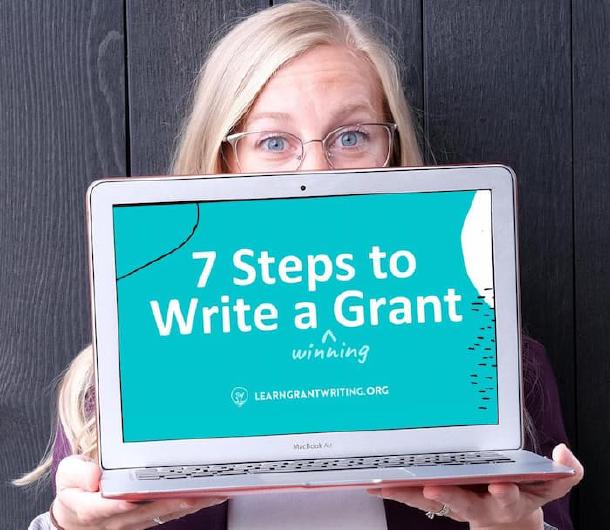
Tip 1: Understand What Grants Are and Are Not.
Quick refresher: A grant is a gift of money awarded to an entity so that the entity can achieve a specific goal or purpose. Typically, this money is awarded from two primary types of funders:
- Government (city, state, and federal).
- Foundations (community and private).
It's important to have a realistic expectation of what grants can do (and cannot do) for your organization.
Grant funding can be an incredible strategic type of funding, but you simply cannot rely on it to get your organization out of the red. In other words, winning grants should be the icing on the cake, not the actual cake. Ideally, grant funding complements your existing development efforts.
It's important to have a diversified fundraising plan, where grant-awarded money constitutes no more than 10-20% of your fundraising goals depending on your organization type.
This is true for any part of your fundraising plan—for example, you should be nervous if a single major donor represents much more than 20% of your yearly revenue. Why? If that revenue stream dries up for whatever reason, you're left high and dry!
Obviously, we love grants here. But what we care about more is that you develop a sustainable, truly effective organization that can cover your base costs.
Key Takeaway:
Grants should help your organization stabilize and grow, not make up the basis (or a risky chunk) of your entire operating budget.
Tip 2: Know Where to Look for Grants.
If you give an executive director an idea for a new revenue stream, they'll probably immediately ask how they can tap into it. The question is this: Where do you find grants?
The first and easiest thing you can do is think about your network. Who is your banker, electric company, insurance provider, etc.? Do they have a grant program or a corporate foundation established? Reach out and ask about the application process. Get to know what they're interested in funding—you'll never know unless you ask!
However, the fastest way to consistently find grant opportunities is to use a grant database.
A database can do in seconds what could take you days to do with Google searches. Visually, it's a much easier way to organize and track grant opportunities. But, which database do I use? Great question. We did the research so you don't have to. Check out our reviews of the top grant databases, plus our final recommendation.
Spoiler Alert:
Our favorite database is Instrumentl. Plus, they provide a discount to students of Learn Grant Writing—use the discount code LGW to get $50 off your first month. Check it out!
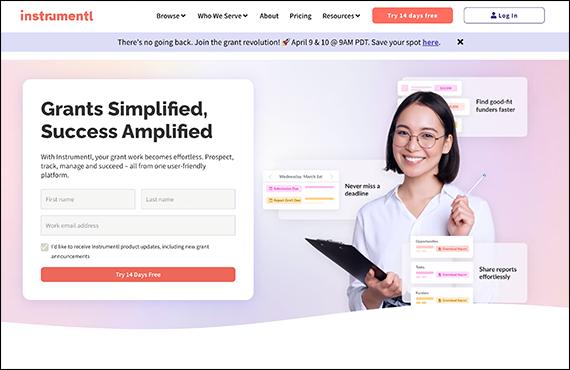
Tip 3: Build Relationships with Grant Funders.
For nonprofit organizations, relationship-building is key to success. The successful pursuit of grant funding is no different.
You should ideally work to build relationships with funders before, during, and after applying for grant funding with that particular agency.
This is a blessing and a curse because while it takes work to build relationships, these connections can help you tremendously. Basically, do what you do best—care for donors as you care for your beneficiaries. Get to know them, invite them to partner with you in your mission, learn more about their funding goals, and engage where they do in the community.
In the same vein, don't neglect to follow up and thank your funders. Be diligent in your reporting and evaluation measurements. Stay connected with the funder throughout the funding cycle. Demonstrate your thankfulness and recognize their gifts how they prefer to be recognized, like with a press release, anonymously, a sign on the door, etc.
Handy Resource:
One of our most popular blog posts covers strategies for "invite-only" funders. In it, you'll find tactical tips for relationship-building (whether the funder is "invite-only" or not.)
Tip 4: Find the Right Grants for Your Nonprofit.
Relationship-building goes hand in hand with researching potential funders for your nonprofit.
As you whittle down your list of funders, be sure to ask who and what they have funded in the past and how much. This will first help you determine whether a funder is the right fit now and then, if you move forward, will inform your ask when you submit applications. You can also learn a great deal about a funder's history through their 990-form data.
Grant research is a huge topic, and, in our opinion, this is the most important step you take to know you are focusing on the right grants in the first place. We even dedicate an entire module in the Global Grant Writers Collective to grant research and prioritization.
Bonus points if you take a deeper dive with Chapters 4, 5, and 13 in our book, How to Write a Grant: Become a Grant Writing Unicorn.
Grant Writing Unicorn Book
#1 bestseller on Amazon for nonprofit fundraising and grants. Do you have a copy of, “How to Write a Grant: Become a Grant Writing Unicorn”?
Get a Copy Now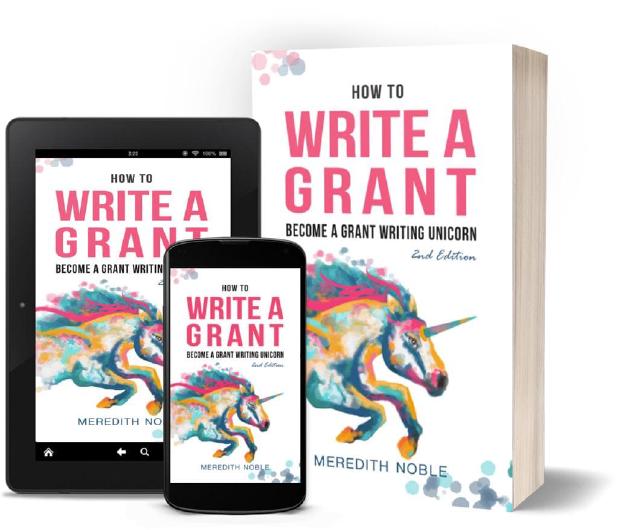
Once you have a manageable list of funders to consider, schedule a call with a program officer. Be sure to check if any of your board members already have a relationship with the funding organization. If so, ask them to coordinate an introduction. In this meeting, your goal is not to sell your organization or proposed project. Instead, be curious. Learn. Objectively evaluate if your organizations are a good fit for each other.
If you bring this mindset shift to your meeting, you will have a much more honest, meaningful, and productive conversation. After all, nothing is worse than spending a ton of time on a grant you have no chance of winning. Be skeptical until you have enough positive data points to confirm the grant is worth your time and resources to pursue.
Crucial Reminder:
If you find yourself stretching your programming plans to make your ask fit within a funder's preferences, stop. Let that grant opportunity go. When you stretch and alter your vision and goals, you're not going to beat out applicants who have missions that perfectly align with the funder's. There are always other grants!
Tip 5: Partner with Other Nonprofits.
This might sound scary, but hear us out. Other nonprofits are not your competition. We're all in this together working to create a better community and world.
Work to adopt an abundance mindset (there are plenty of resources available for us all) versus a scarcity mindset (there aren't enough resources to go around).
By partnering with other nonprofits on a specific project, you can:
- Demonstrate to funders that you're willing to work collaboratively (and isn't that the definition of life at a nonprofit—collaboration?)
- Give the funder the opportunity to support multiple organizations in just one project. It's hard to say no to a well-developed, collaborative, and creative project that supports multiple missions.
- Expand your organization's reach, both in terms of providing your services and reaching new donors.
For example, I recently wrote two Housing and Urban Development grants for two different rural Alaskan communities. Per the funding guidelines, the proposed project required applicants to hire a Project Manager who would be a .5 FTE (full-time equivalent). The two communities agreed to share that Project Manager who would split their time between each village. Since these two villages were pursuing the same grant in the same funding cycle, the two village representatives attended our project meetings together and helped one another submit the best possible proposals.
And, you know what? They both were awarded funding ($1.3 million! #humblebrag). How much more fun that the two villages could celebrate together?!
Key Takeaway:
Don't be afraid to collaborate. Choose generosity over fear of scarcity—it pays off.
Tip 6: Spend Enough Time on the Grant Application.
We've seen this before and it's not pretty. That's why we're going to say it louder for the people in the back: 📣 Spend more than five minutes on the grant application! 📣
Even a short application from a small community foundation takes time and intentionality. Even an "easy grant" that you're confident you'll win requires time.
Tough love: You're not doing yourself, your organization, or who you serve any favors by rushing through the application. Slow down and remember the basics of good writing. Complete sentences, the craft of story, persuasion, etc.
✏️ Free Writing Resource ✏️
We actually built an entire course on writing for grant writers—check it out!
Don't forget to consider asking for help. Could you delegate portions of the grant application to a Board member, volunteer, intern, or other staff member?
There's no shame in asking for help when you need it and when it will benefit your organization as a whole! Recognize others' strengths, ask them for their expertise, and then take the lead on pulling it all together into a single, coherent message.
Important Note:
The prerequisite here is that you've taken Tip 4 (funding research) to heart. You must be confident you're focusing on the right grants in the first place. It's best to do fewer high-quality grant proposals than throw everything at the wall and "see what sticks."
Tip 7: Recycle Grant Proposal Content Thoughtfully.
We're all for repurposing grant proposal content because it can save you a lot of time and energy during the drafting process.
However, you will still need to update (even upcycle) any previous content. Even if you apply to the same foundation year after year, find ways to improve and change your application. Grant reviewers notice when you submit the exact same grant application repeatedly. They can tell how much work you did or did not put into the application, which influences their final decision.
Always ensure that the content you're repurposing appropriately answers questions in the application. This will require you to slow down a bit and think through the questions, but again, it's worth it. Chances are the last proposal had slightly different questions, meaning you'll need slightly different responses in the current proposal.
Pro Tip:
AI technology is changing the game everywhere, including grant writing. With AI tools that speed up researching and drafting your proposals, you can focus on perfecting them. Learn Grant Writing offers an industry-leading AI grant writing tool, available through the Global Grant Writers Collective—get in touch to learn more!
Tip 8: Have Your Application Independently Reviewed.
Per best practice taught here at Learn Grant Writing, we always recommend having an independent review of your grant application before submission.
Why? You live and breathe the mission, while an outsider will spot holes in the narrative and catch things you unintentionally missed.
Recruit someone who hasn't been deeply involved in the grant writing project and is unfamiliar with what you're proposing. You might even collaborate with a fellow, trusted nonprofit organization (Tip #5 coming in hot again!). Perhaps the pair of you could exchange final drafts of your grant proposals for mutual review.
Fun Fact:
One of the first grants written by a member of our team was when she worked at a nonprofit organization. She was mentored through the grant writing process by a senior grant writer from a different organization. Both organizations were applying for the same grant funding. Different asks, of course, but they were pursuing funding in the same funding cycle from the same funder— and both organizations won funding!
Tip 9: Stay Grant-Ready.
When you stay grant-ready, you don't have to get grant-ready.
Before diving into grant prospecting and certainly before tackling your first proposal, spend some time preparing. Grant readiness means being prepared financially and organizationally at both the program/project and organization levels.
In other words, the back end of things should be in order before you apply for funding. Of course, you will still work through application-specific details, but the process is much smoother the more prepared you are and the more standard documentation you have on hand.
These will come in handy throughout the various parts of a standard grant proposal, particularly sections concerning organizational background, project details, budgets, logistical plans, and required supplemental documentation.
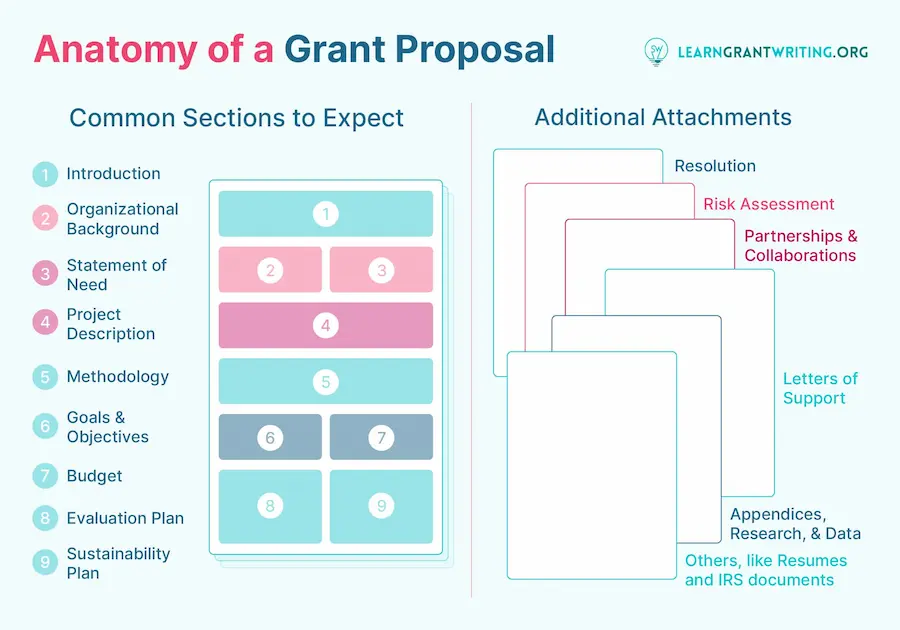
Here's a short, non-exhaustive list of key documents we recommend keeping at the ready:
- Tax Exempt Status Letter
- IRS Form 990
- W-9
- Strategic Plan
- Organizational Chart
- List of Board of Directors
- Audited Financial Statements (if you are large enough to have these)
- Previous Annual Reports
- Program/Project Details, including a scope of work description, outcome measures, target population, relevant statistics, etc.
- History of Grants Received
- And potentially more depending on the specifics of your grant
Also, if you aim to apply for federal funding, you'll need a Dun & Bradstreet (DUNS) number and a System for Award Management (SAM) registration.
Proper preparation will help the grant writing process go smoothly for you. Ensuring you have all this information easily accessible in a central "grant readiness folder" is a great place to start.
Don't Worry:
If you find this all a bit overwhelming, take a deep breath! It's not nearly as complicated as it sounds. It's just about getting organized so you can find the information you need to write grants efficiently and effectively. (We even teach a file organization structure in the Global Grant Writers Collective.)
Tip 10: Get Some Professional Grant Writing Training.
Whether you work in a nonprofit and have been asked to write a grant or want to start a freelancing side hustle, professional grant training will be a major asset for you.
Or, maybe you're too busy to do grant writing yourself and decide to hire a grant writer for your organization. But without a proficient understanding of the grant writing process, you won't be able to identify a stellar grant writer from one that is terrible. (Trust us, we have heard plenty of horror stories!)
By getting professionally trained to write grants, you'll save yourself thousands of lost dollars and skip years of frustration learning everything the hard way. Spend three hours a week for 4-6 weeks, and you'll know the exact steps to take to:
- Stay organized and master grant jargon
- Research and prioritize grant opportunities
- Develop a (super impressive) funding strategy
- Prepare and write winning proposals
In short, you can become a grant writing unicorn faster than you might realize.
Back in the day, live workshops were the most common way to receive continued education in grant writing. The problem, however, is that our minds can only soak up so much information in one sitting! Plus, what are you supposed to do when the workshop ends and you get stuck on a real project? Grant writing can be a lonely business!
That's why we shifted grant writing training online. Our approach gives you time to apply lessons to a real-world project and ask questions when you encounter hurdles in real time. We've created a thriving community of fellow grant writers and students to learn from each other, something you won't easily find in one-time, in-person offerings.
Want to see if the way we teach grant writing works for you? Do yourself a favor and check out this training: How to write fewer proposals and win more grant funding as a confident nonprofit grant writer.
Working as a nonprofit grant writer? Want to write fewer proposals and win more funding? We built this training just for you. Check it out!
As a nonprofit professional, you're busy and your time is precious—we get it. These tips and considerations are designed to help you utilize your time well. Go forth, win grants, let us know how it goes, and continue to serve your community well!
Remember, check out this training on winning more funding by writing fewer proposals, and keep exploring with these additional resources for grant writers:
